Warning: pic heavy, as usual.
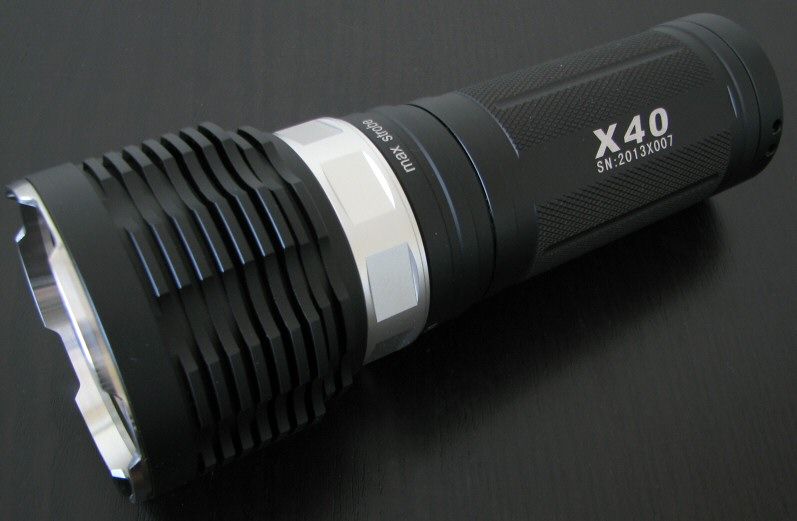
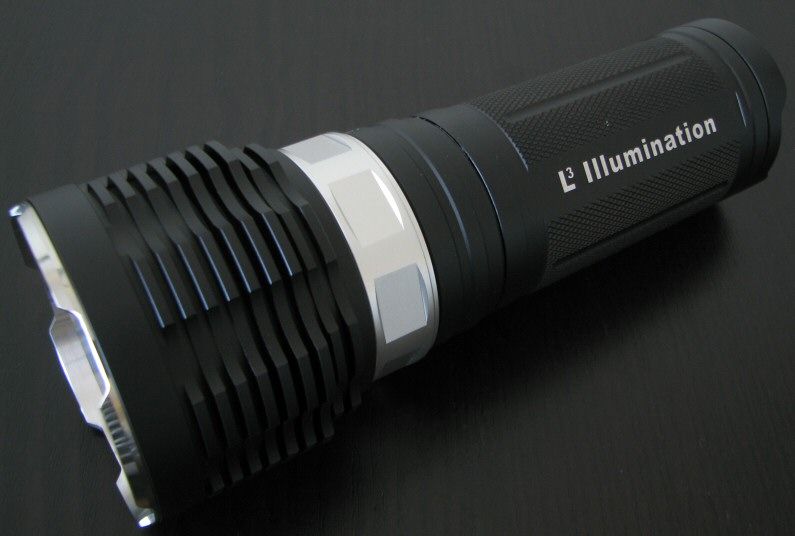
The X40 is the first light I've reviewed from L3 Illumination – and what a place to start, given the specs (see below). I'll put the light through its paces, and see how it comes out compared to other recent high-output lights. :wave:
Manufacturer's Specifications:
Note: as always, these are only what the manufacturer reports. To see my actual testing results, scroll down the review.
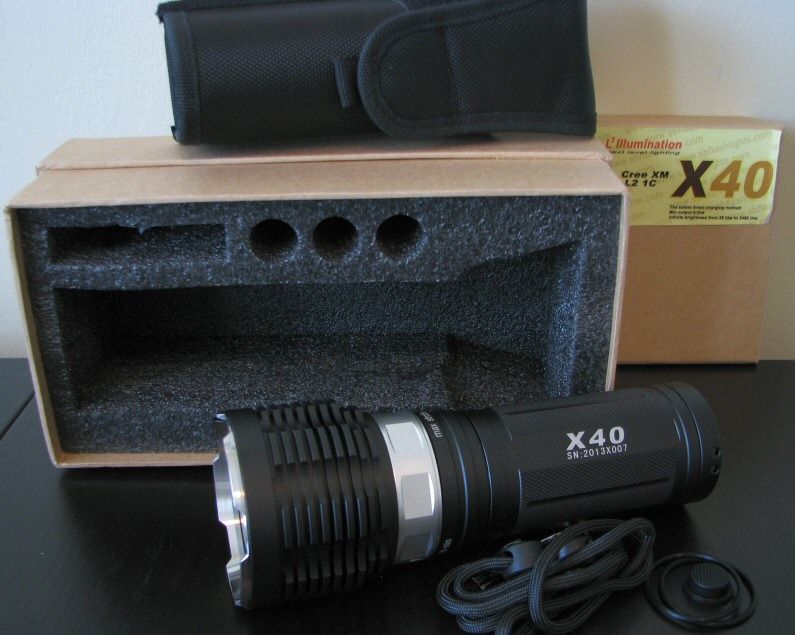
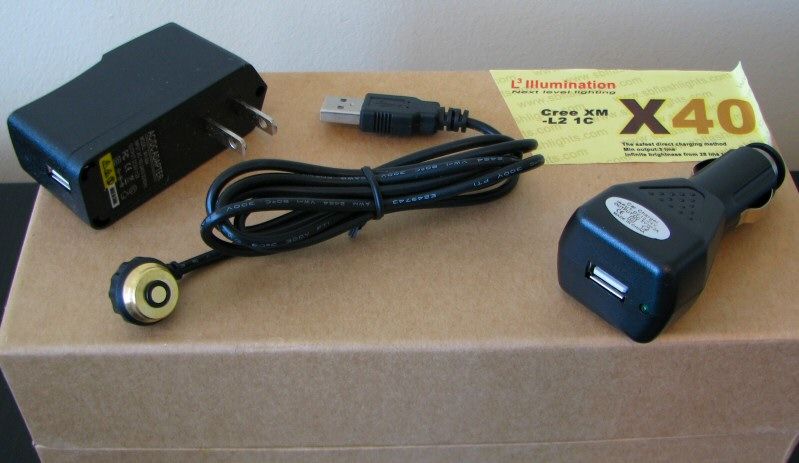
My X40 came in a hard cardboard box with cut-out packing foam. Along with the light was a good quality lanyard, belt holster with closing flap, extra o-rings, spare tail switch boot cover, USB charging cable with AC adapter and DC car adapter. The manual wasn't ready when the light was shipped to me, but I was supplied with an electronic copy.
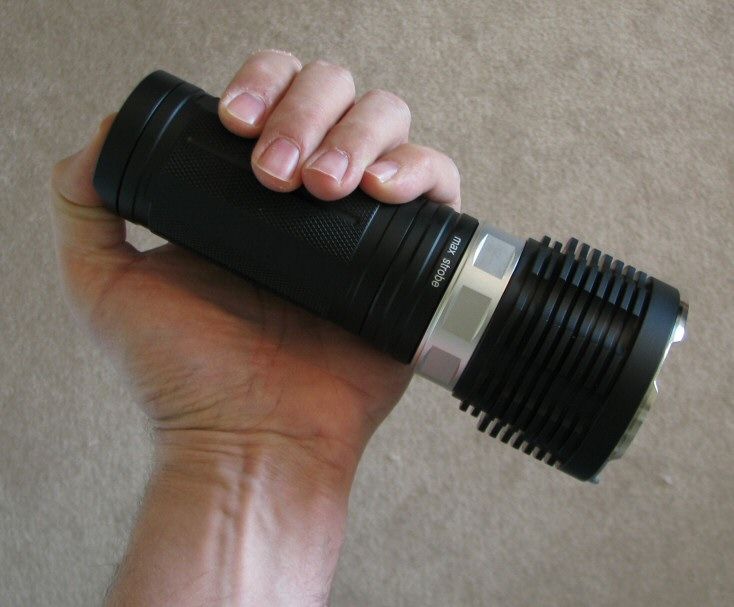
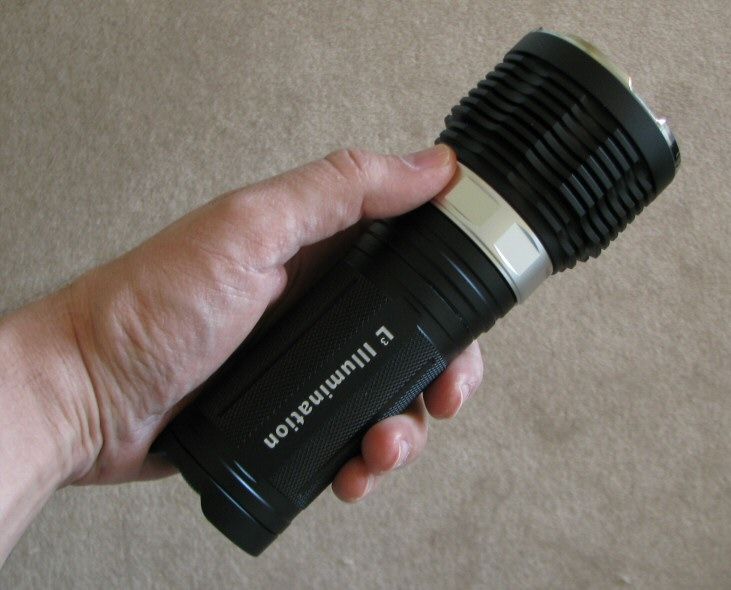
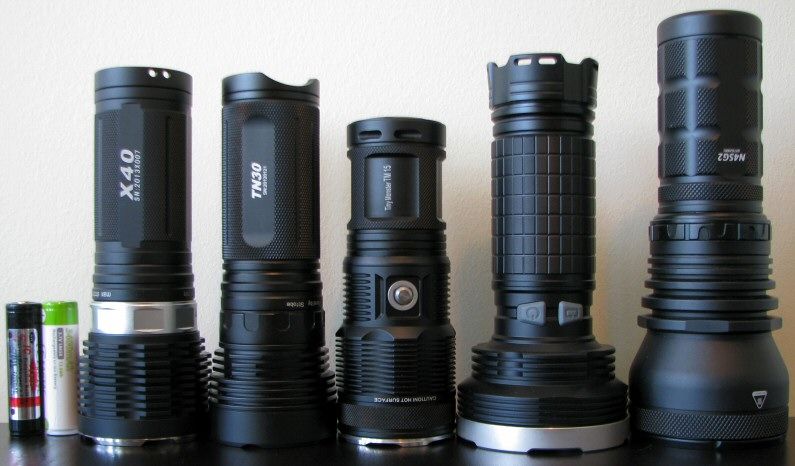
From left to right: AW Protected 18650; Eagletac Protected 3400mAh; L3 X40; Thrunite TN30; Nitecore TM15; Fenix TK75; Niwalker BK-FA02.
All dimensions are directly measured, and given with no batteries installed:
L3 Illumination X40: Weight: 517.2g (~655g with 3x18650), Length: 182mm, Width (bezel): 68.0mm
Fenix TK75: Weight: 516.0g (~700g with 4x18650), Length: 184mm, Width (bezel): 87.5mm
Nitecore TM15: Weight: 450.6g (~634g with 4x18650). Length: 158mm, Width (bezel): 59.5mm
Nitecore TM11: Weight: 342.6g (~526g with 8xCR123A), Length 135.3mm, Width (bezel): 59.5mm
Sunwayman T60CS: Weight: 338.9g (~477g with 3x18650), Length: 145.0mm, Width (bezel): 60.0mm
Thrunite TN30: Weight: 468.2g (~620g with 3x18650), Length: 179mm, Width (bezel): 64.3mm, Width (tailcap): 49.0mm
Xtar S1 Production: Weight: 876.0g (~1028g with 3x18650 protected), Length: 240mm, Width (bezel): 83.4mm
Olight SR92: Weight: 1.15 kg (with battery pack), Length: 271mm, Width (bezel): 98mm
The overall size and weight of the X40 is in keeping with other lights of this class. Note there is a lot of variation in the class, depending on what features you are looking for.
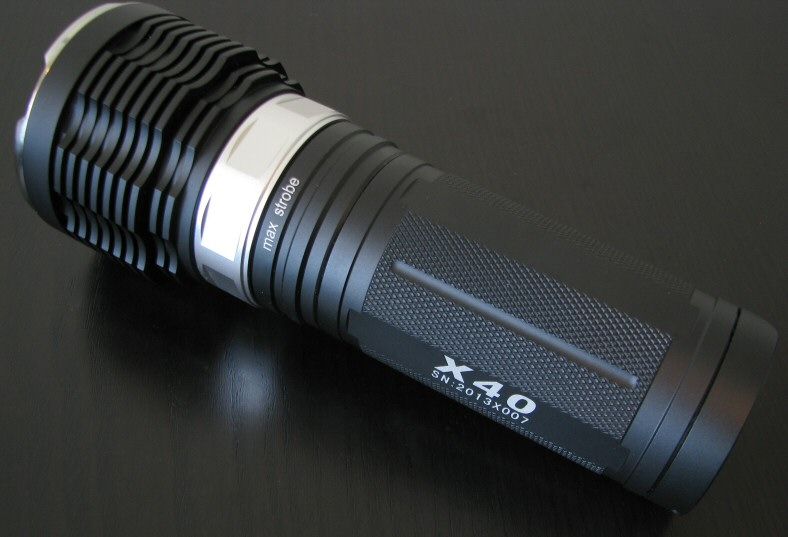
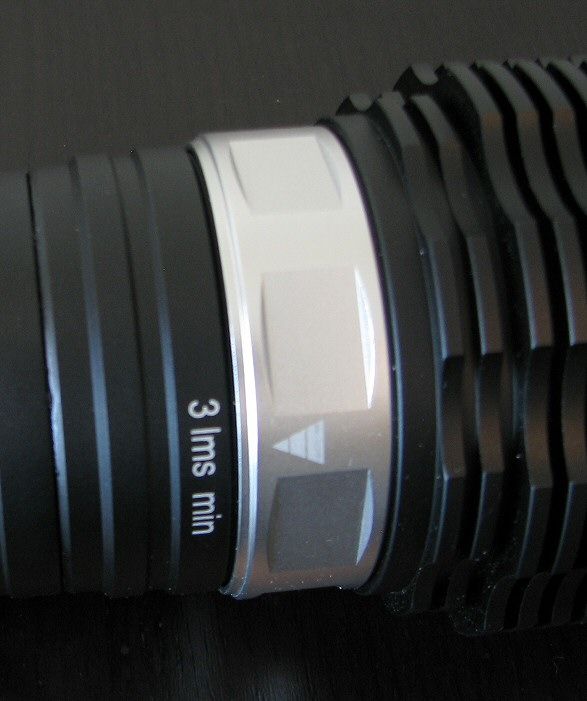
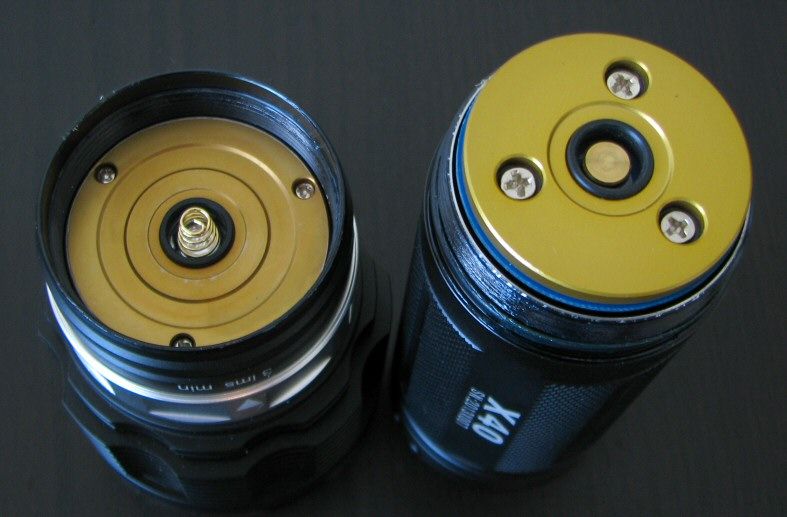
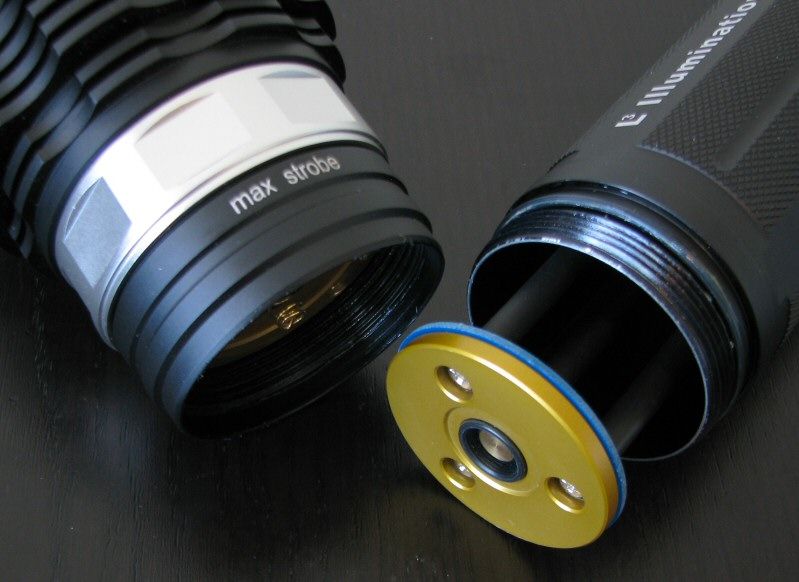
The X40 build is probably most reminiscent of the Thrunite TN30, although with a more distinctive control ring (more on that in a moment). Anodizing is a flat black, and seems to be in very good shape on my sample. Labels are sharp and clear, and include a serial number.
Knurling is present over most of the handle, and is of fairly high aggressiveness. Combined with the control ring flats and heatsink fins in the head, I would say overall grip is pretty good. Light can roll fairly easily, but the indented flats in the head help limit that somewhat.
There are flat indents on the control ring to help with feel. There is a label mark on the control ring that lines up with the labels on the head. Going clockwise, the output modes are min output "3 lms" (first detent), lowest level of the continuously-variable ramp (second detent), output ramp, "max" output (third detent) and "strobe" (fourth detent). The detents are firm at each level, with even resistance across the ramp area.
Screw threads are traditional triangular cut, but seem of good quality.
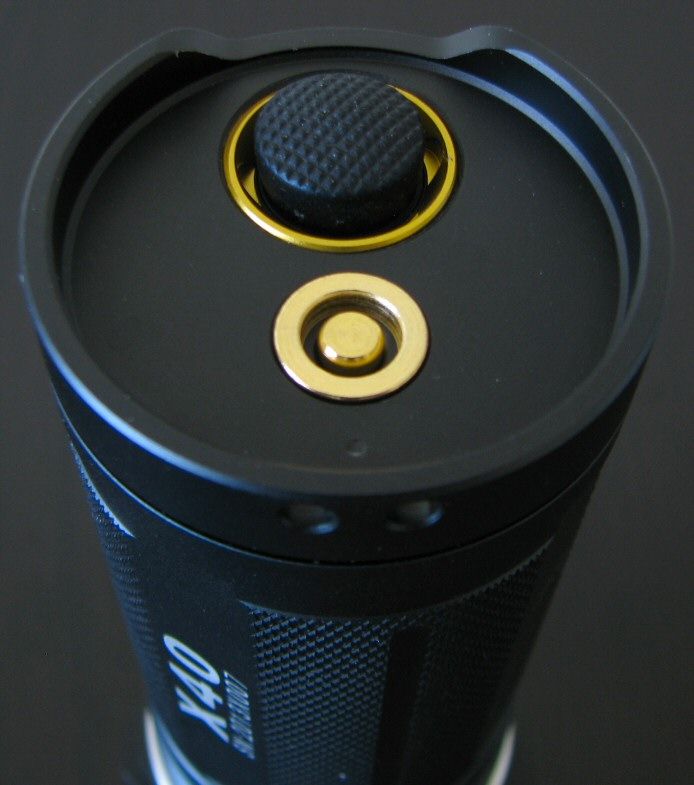
The light can tailstand stably, and the tailcap cut-outs facilitate access to the switch. Switch is a forward clicky switch (i.e., press for momentary, click for locked-on). Switch feel has a slightly longer traverse than typical, with a definite click. There is a charging dock in the tail that connects to the supplied USB-cable. See below for a discussion.
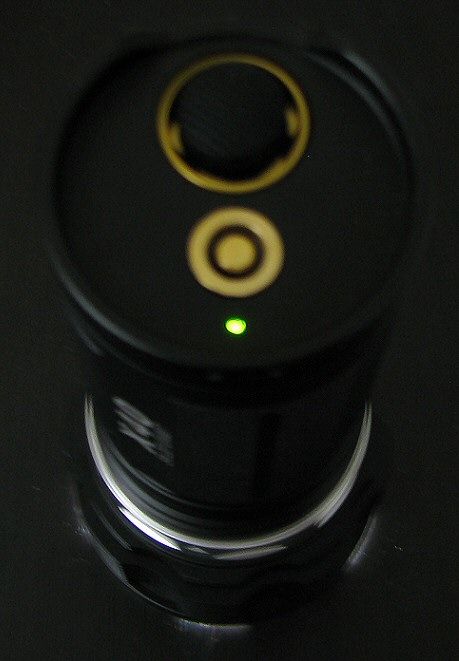
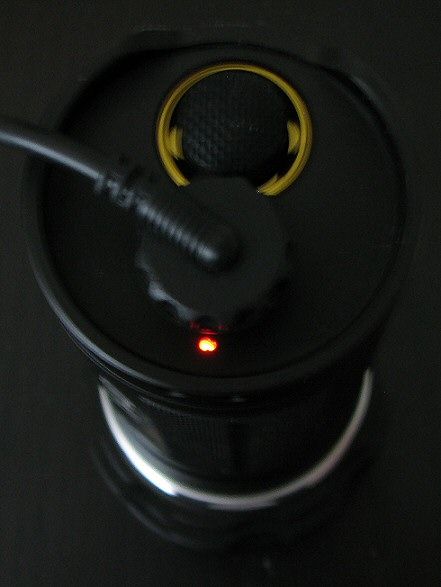
There is also a small LED indicator. It is green when the light is on and the batteries well charged (or, when charging, if the batteries are fully charged). It is orange when on and the batteries are <50% power. It is red when on and the batteries are <30% (or when batteries are being charged), and flashing red when the on and the batteries are <10%.
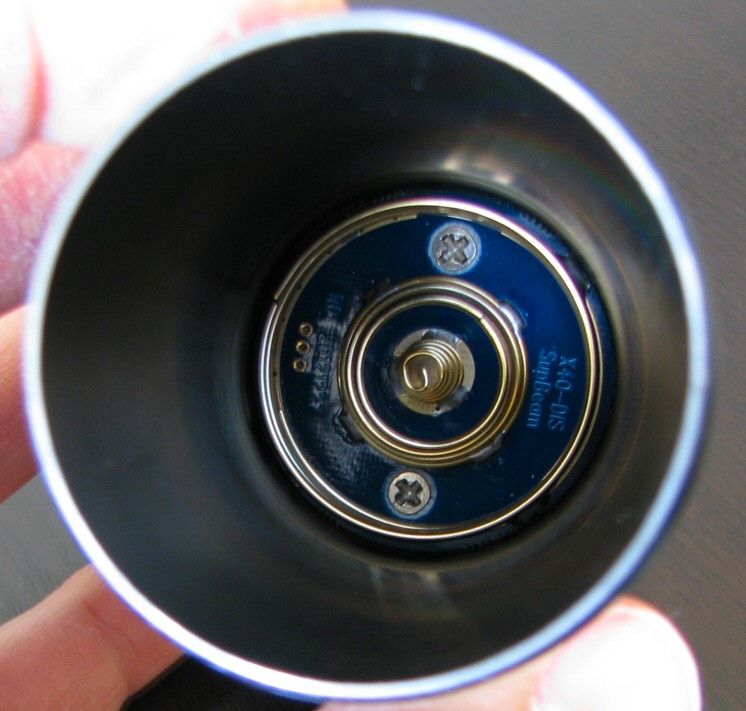
There is a triple set of springs in the base, in addition to the spring in the head. The extra set of springs in the tail is obviously required for the charging feature. FYI, I notice the contact board says SupBeam X40 …
Let's take a closer look at the battery carrier:
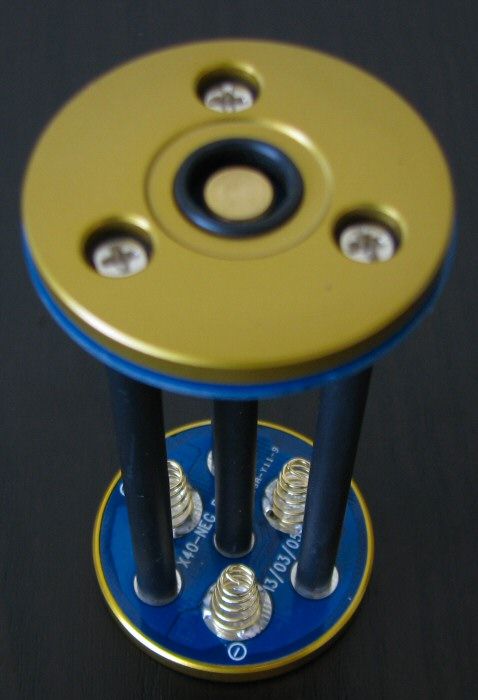
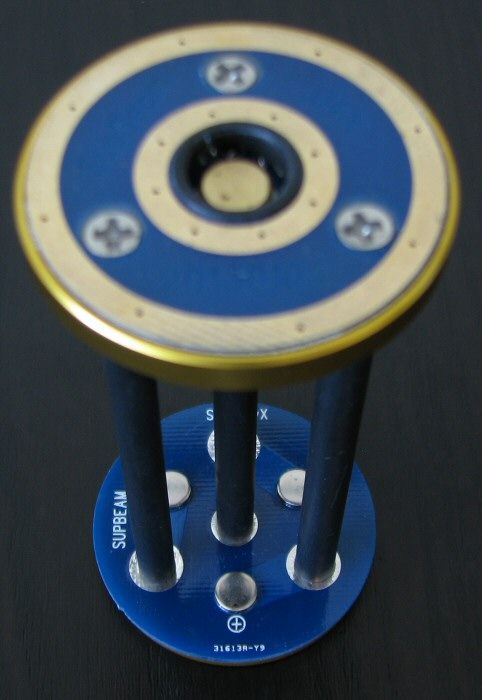
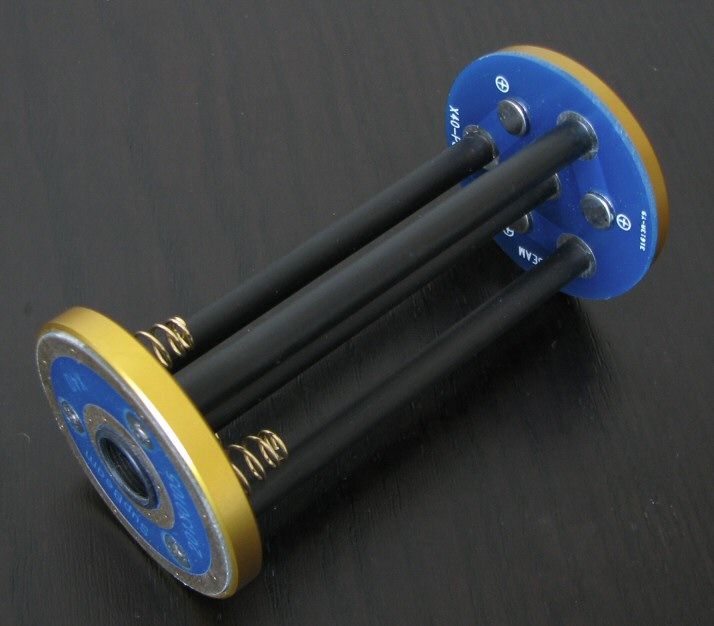
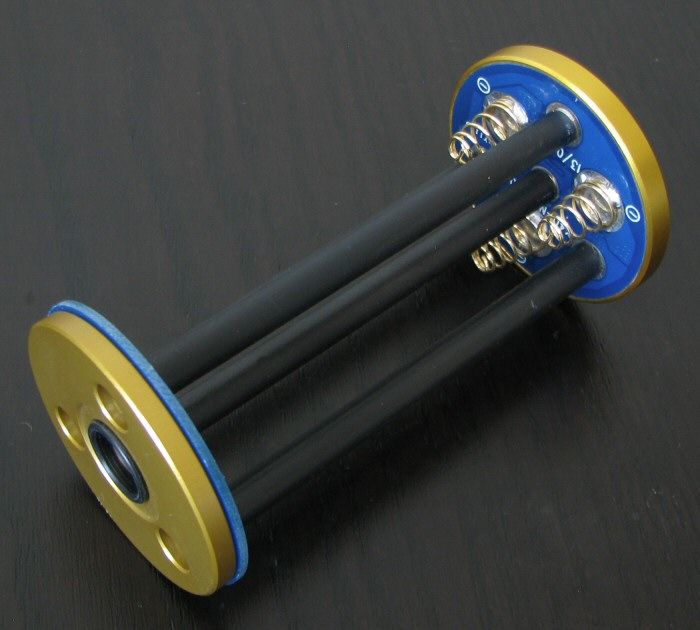
There is a metal battery carrier that holds 3x 18650 cells. The positive contact points inside the carrier are slightly raised, so all types of 18650 cells should work fine (i.e., true flat-tops, wide and small button-tops). Longer cells may be a bit tight with the base springs, but my protected 3100mAh cells all fit (although some wider cells may make it harder to fit the loaded carrier back into the handle). Unlike other carriers, all the cells point the same way here (i.e., negative terminals at the base, positive terminals toward the head). The carrier is a 3s arrangement (i.e., all cells in series, not parallel).
The carrier only functions one way, with the contact board facing the springs in the tailcap. The inner-most positive contact of the carrier is recessed at both ends, and there is a large metal plate at the carrier end that contacts toward the head. Note that the negative current path is carried by the body of the light. The positive path connects through the spring in the head unit.
Note that CR123A are not supported – the X40 is 3x18650 only.
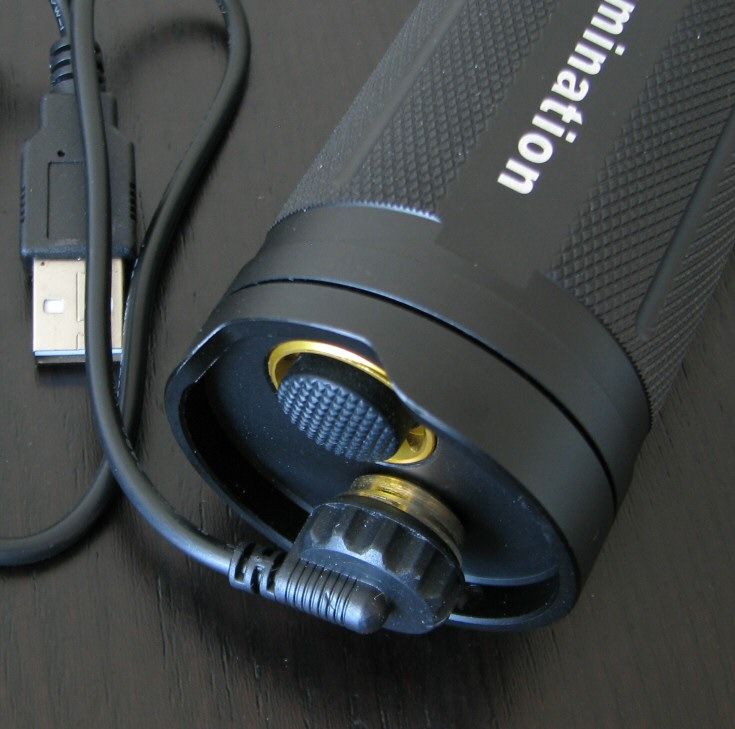
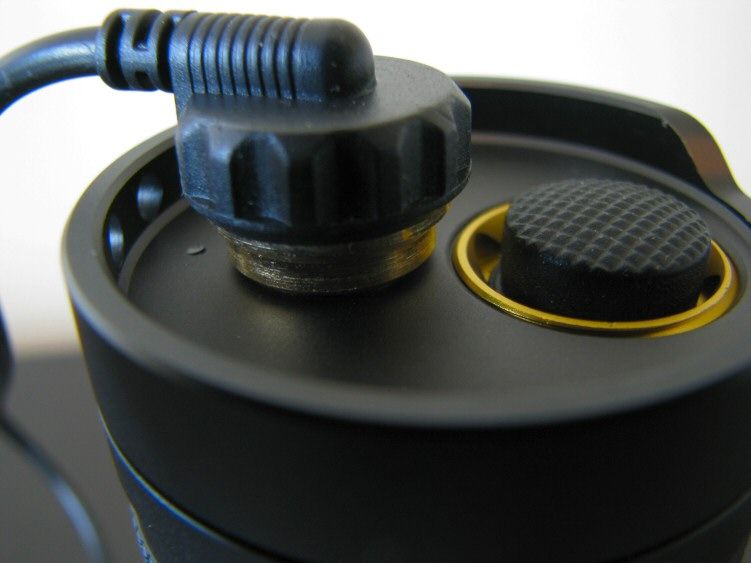
The charging dock is interesting. Like the Klarus RS11 (which this charging solution resembles), the dock is magnetic and there is no open voltage at the tail (i.e., no risk of shorting when cells are loaded). What you see at the exterior base are two metal circular contacts – these are connected to the terminals of the carrier through the springs. The charging cable directly attaches to the external contacts through a strong magnetic connection, just like the Klarus RS11.
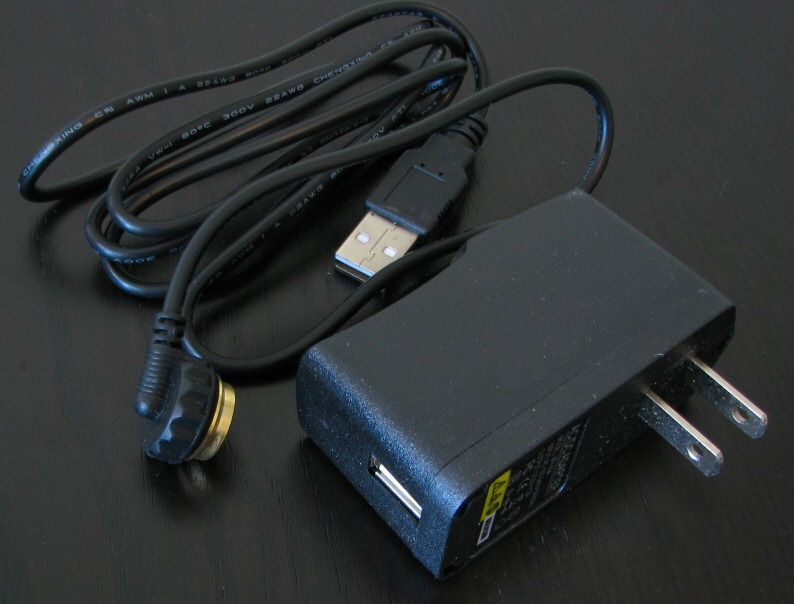
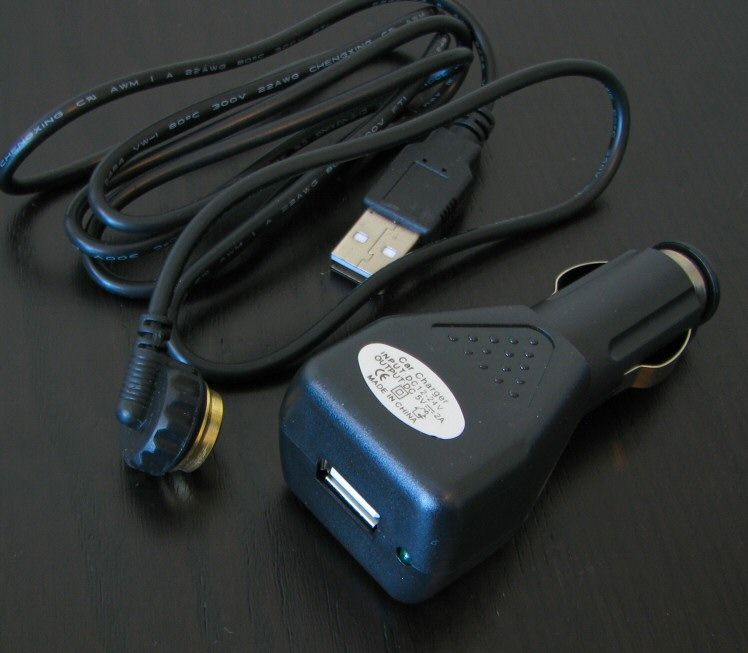
Both AC and 12V DC adapters were provided on my sample.
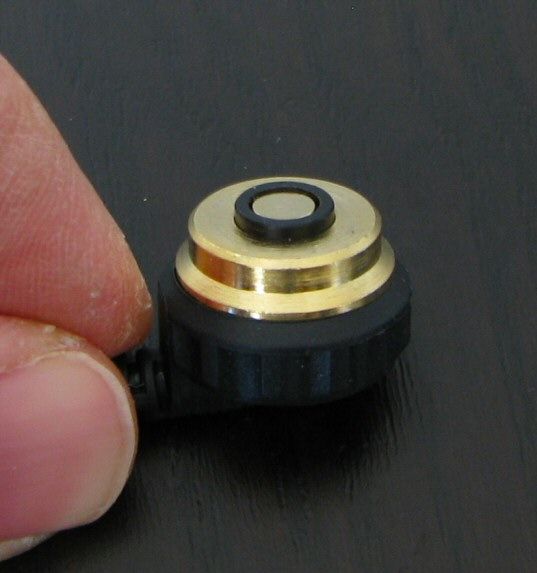
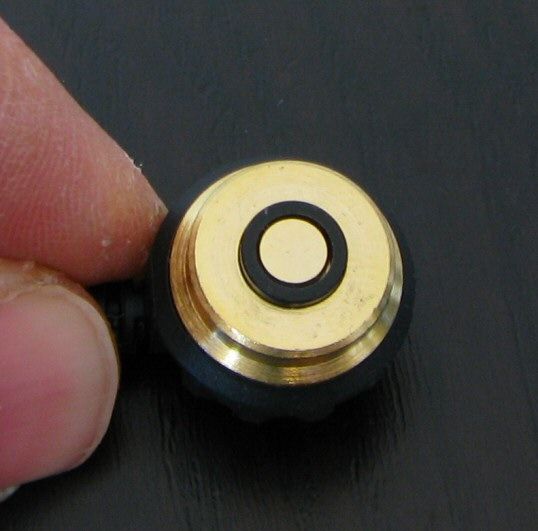
Because of the strong magnetic pull of the charging cable head (i.e., it will attach itself to anything made of metal), I recommend you connect the head to the flashlight BEFORE you connect the USB end to your computer or an AC power adapter. The reason for this is that when the USB end is plugged in to a power source, I can measure an open voltage at the charger head. Should the magnetic head of the cable then attract a nearby piece of metal, you could potentially short out your USB port (or worse, your AC outlet).
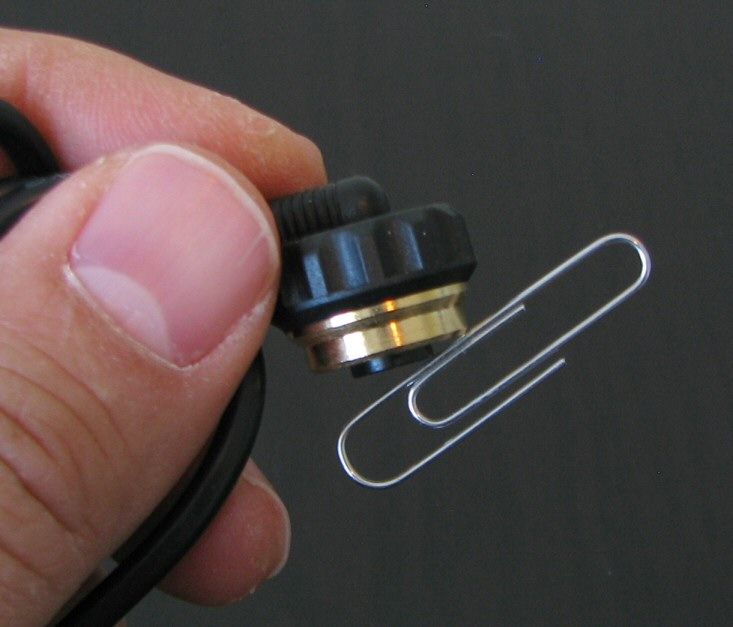
The risk of this is probably fairly low, as there is a raised plastic divider separating the inner and outer contacts on the charging cable to prevent this from happening (i.e., see the pic above with the paperclip). So on a perfectly flat metal surface, you should be fine. But given that the magnet is fairly strong, I wouldn't want to trust that tiny bit of plastic to rule out the potential for even a momentary short. You are better off making sure the magnetic end makes contact before the USB end does.
Using the AC adapter, charging time was a little under 6 hours for fully-drained AW protected 2200mAh cells. The charging rate was longer on just a USB (2.0) port - it took just under 9 hours to full charge my 2200mAh AW cells from the tripped state. This rate seems rather high for me for a standard USB port, so I recommend use of the adapter. I would expect it to take longer for higher capacity cells. Resting voltages for the cells (once the indicator went green) were ~4.15-4.17V, which is quite reasonable.
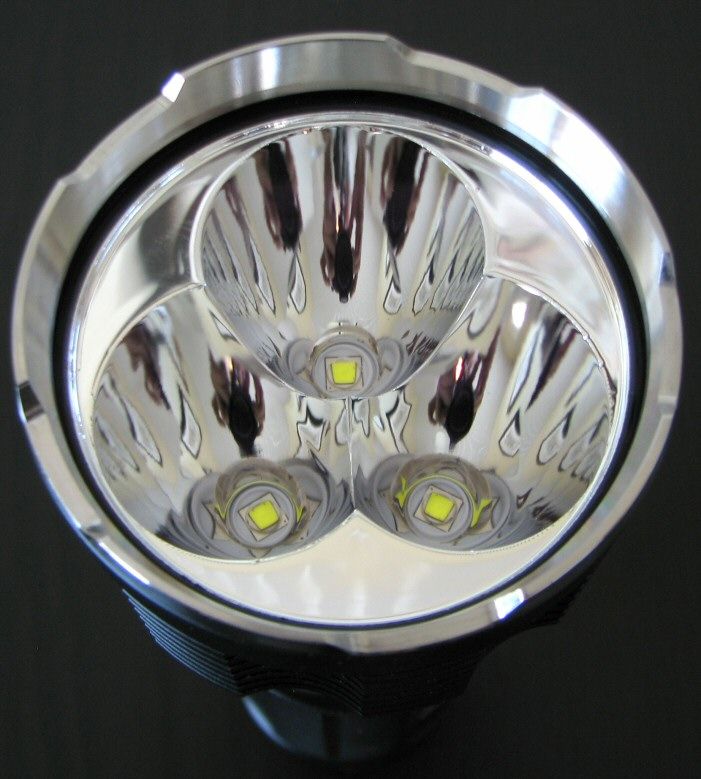
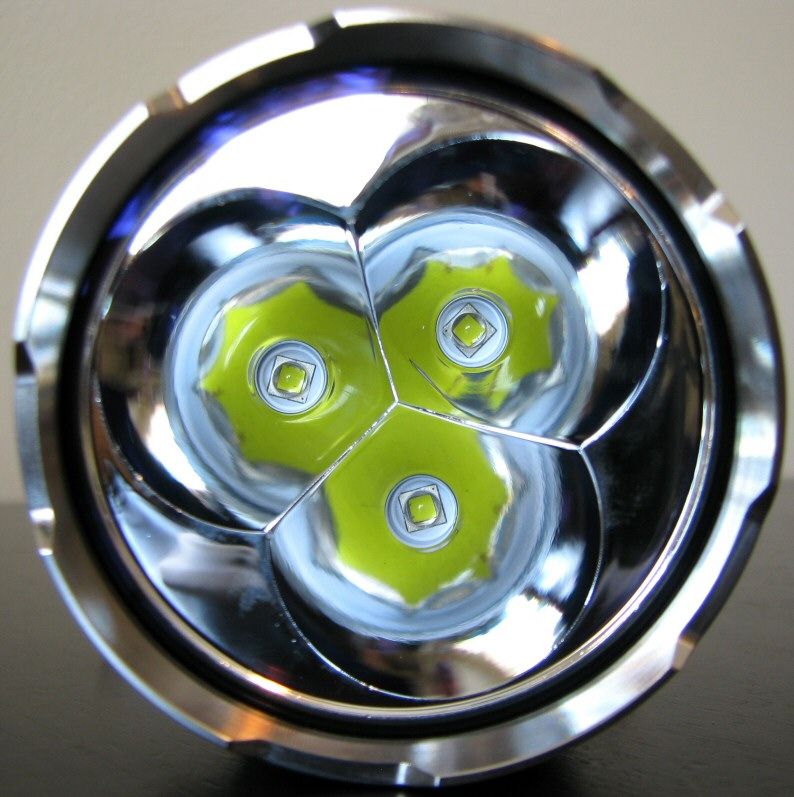
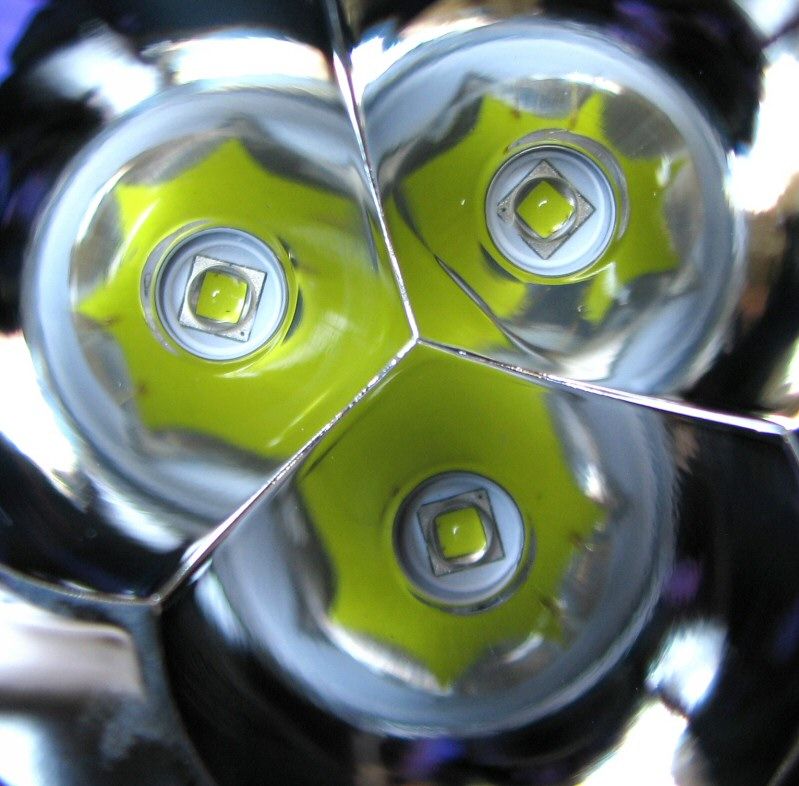
The X40's reflector has relatively deep emitter wells, overlapping a significant amount in the middle. Although there is no such thing as a "typical" tri-head structure, this seems pretty close to the average of the various heads I've seen. The reflector appears to be in excellent shape on my sample, very smooth, with three reasonably well-centered XM-L2 U2 cool white emitters.
The overall impression of the build is that this is a quality light. It is at least on par with my Thrunite TN-series lights.
It is at least on par with my Thrunite TN-series lights.
User Interface
Turn the light off/on by the tailcap clicky – press for momentary, press and release (i.e., click) for constant on.
Change output modes by turning the control ring in the head. Arranged from clockwise/left-to-right (looking down at the light, held in traditional flashlight carry), the modes are detent 1 (moonlight) > detent 2 (lowest level of the ramp) > continusouly-variable ramp > detent 3 (max) > detent 4 (strobe).
Note that there is no standby mode – light is always produced when clicked on.
Video:
For more information on the light, including the build and user interface, please see my video overview:
Video was recorded in 720p, but YouTube typically defaults to 360p. Once the video is running, you can click on the configuration settings icon and select the higher 480p to 720p options. You can also run full-screen.
As with all my videos, I recommend you have annotations turned on. I commonly update the commentary with additional information or clarifications before publicly releasing the video.
Ramping Pattern:
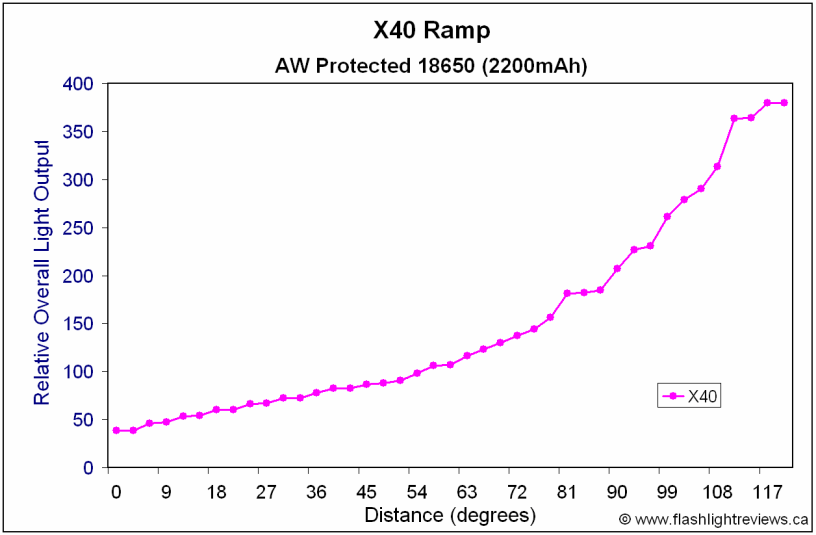
The X40's "continuously-variable" ramp is actually composed of a series of discrete steps. Technically, all "continuously-variable" ramps actually have discrete steps – it is just a question of how many there are, and can you notice them. It is hard for me to give a precise number, but I would say there are at least ~25-30 discrete levels in this case.
The raw data coming out my lightbox (above) doesn't actually give you a good feel for how "visually linear" the X40 is. For that, I have plotted the results on a cube root scale, based on modern perceptual research that shows we actually perceive non-point sources of light according to this power relationship:
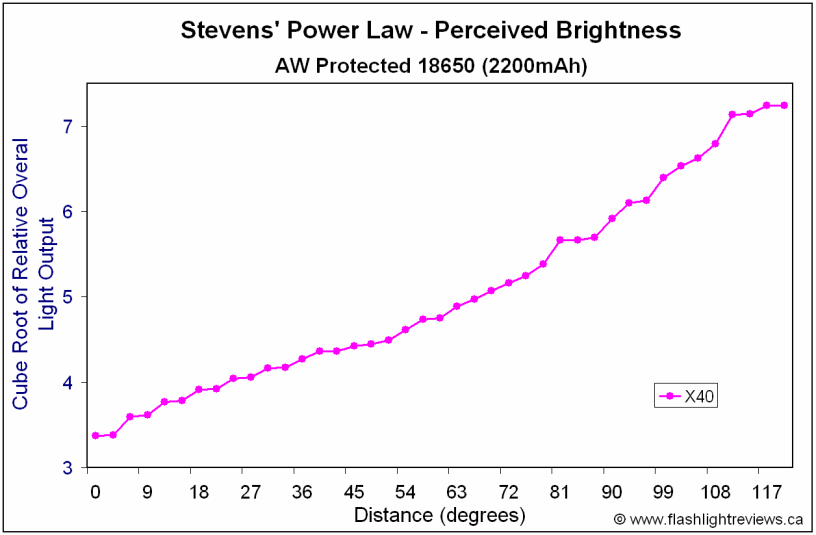
The X40 ramp looks very linear to my eyes.
Strobe
There is no sign of PWM on any level – I believe the light is current-controlled. Even my moonlight mode was flicker-free. :thumbsup:
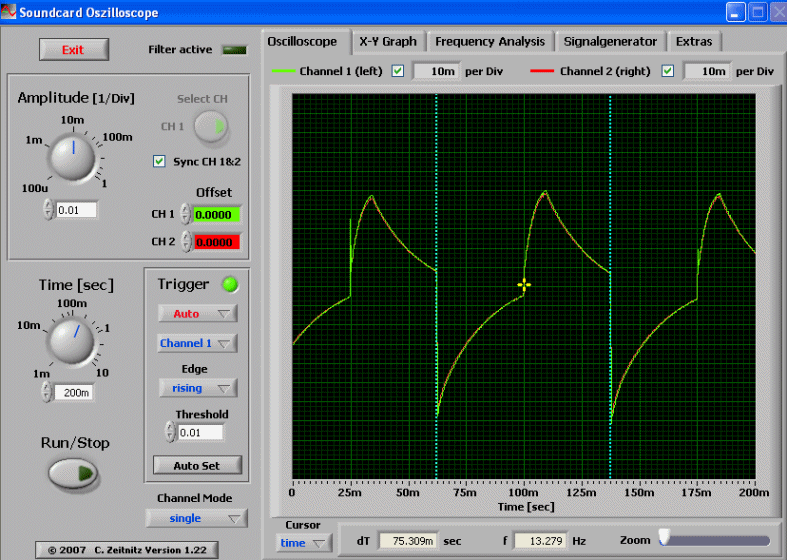
The X40 uses a fairly fast "tactical" strobe, of 13.3 Hz. The oscilloscope trace looks a little unusual during the "on" phase, with a quick spike followed by a ramp up and down from max. Not to worry, it is very disorienting.
No Standby Drain
I don't see any evidence of a current drain when the clicky switch is off.
Beamshots:
And now, what you have all been waiting for. All lights are on their respective max rechargeable battery sources (i.e., 18650s), about ~0.75 meter from a white wall (with the camera ~1.25 meters back from the wall). Automatic white balance on the camera, to minimize tint differences.
All lights are on their respective max rechargeable battery sources (i.e., 18650s), about ~0.75 meter from a white wall (with the camera ~1.25 meters back from the wall). Automatic white balance on the camera, to minimize tint differences.
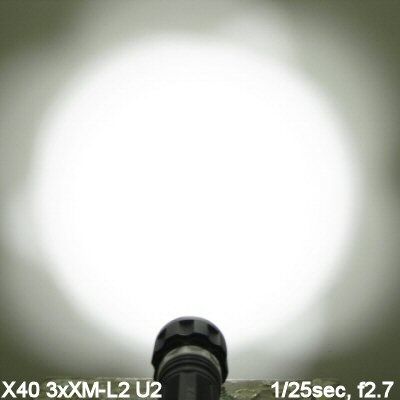
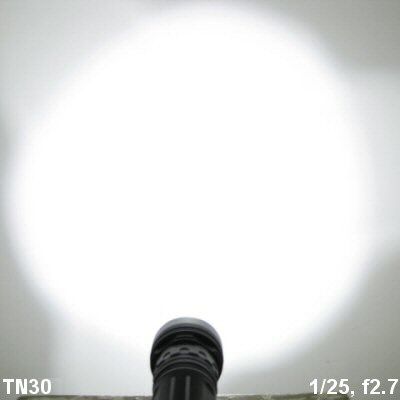
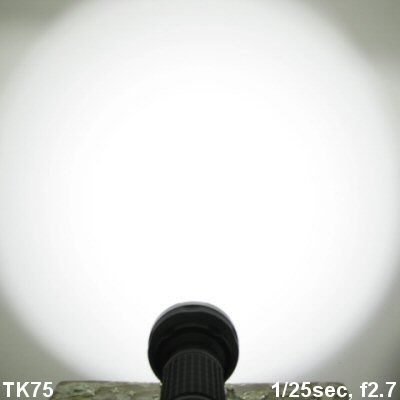
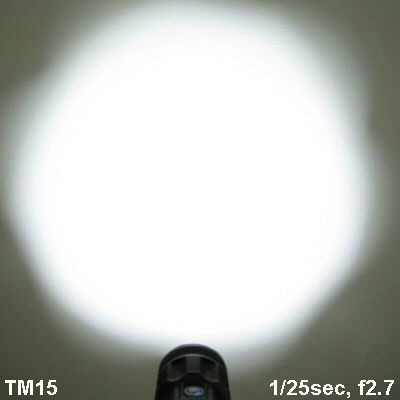
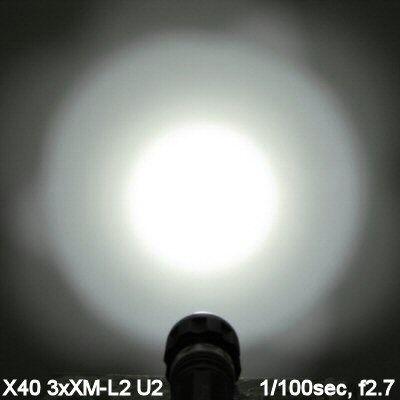
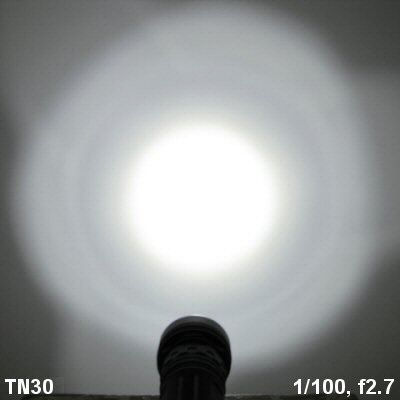
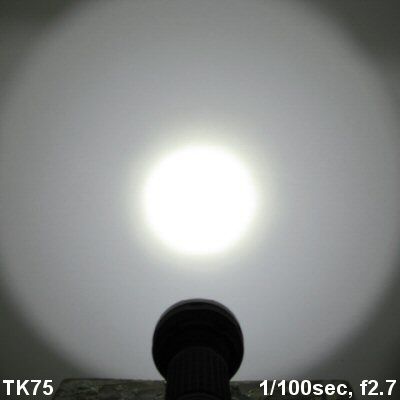
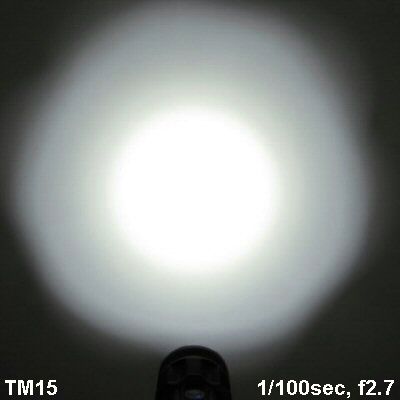
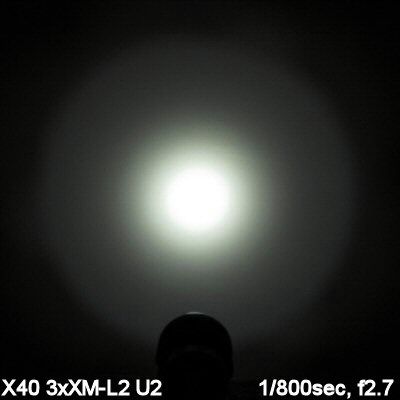
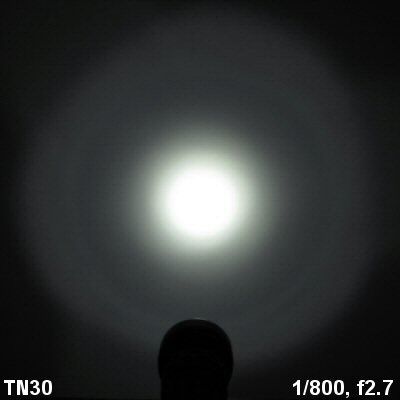
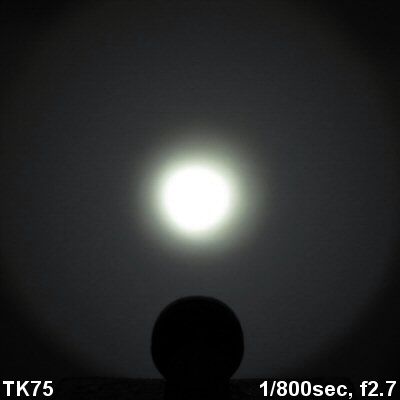
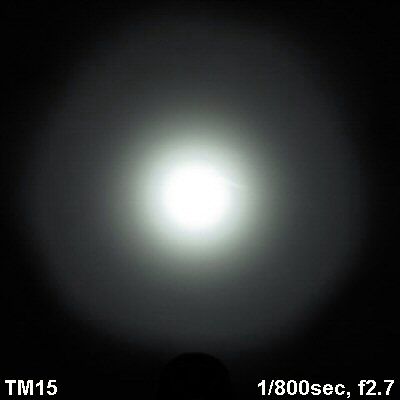
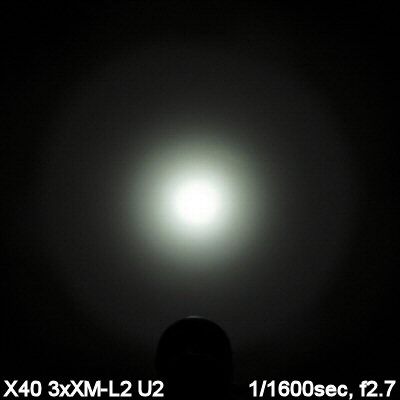
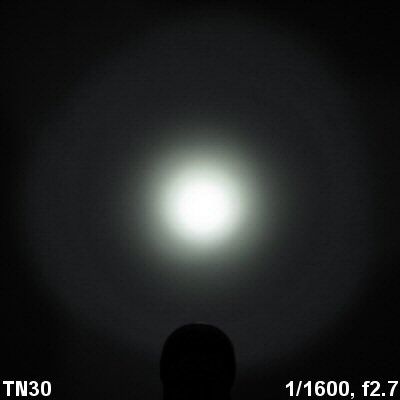
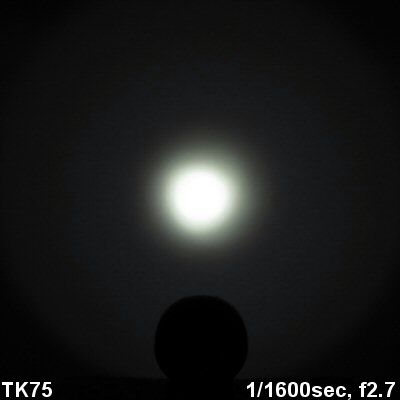
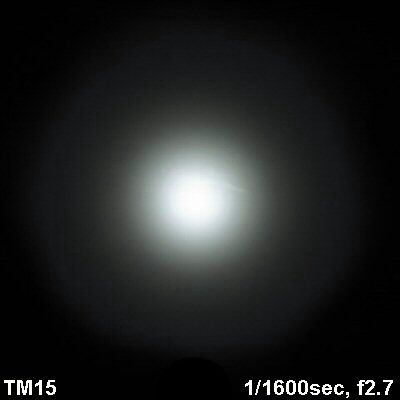
The X40 definitely has an impressive output level on max. Beam pattern is about "typical" for a tri-head (overlapping well) reflector design – you get reasonable throw, with a lot of artifacts in the spillbeam. It is a bit more focused for throw than the Thrunite TN30.
For outdoor beamshots, these are all done in the style of my earlier 100-yard round-up review. Please see that thread for a discussion of the topography (i.e. the road dips in the distance, to better show you the corona in the mid-ground).
FYI, any "streaks" you see across the images are bug-trails. Flying insects are often attracted to the bright lights, and their flight trails get captured as swirly streaks due to the long exposure time.
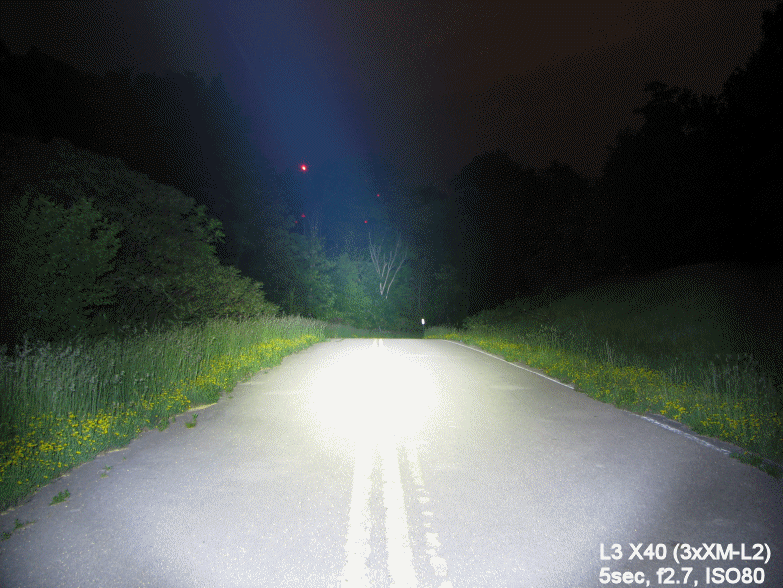
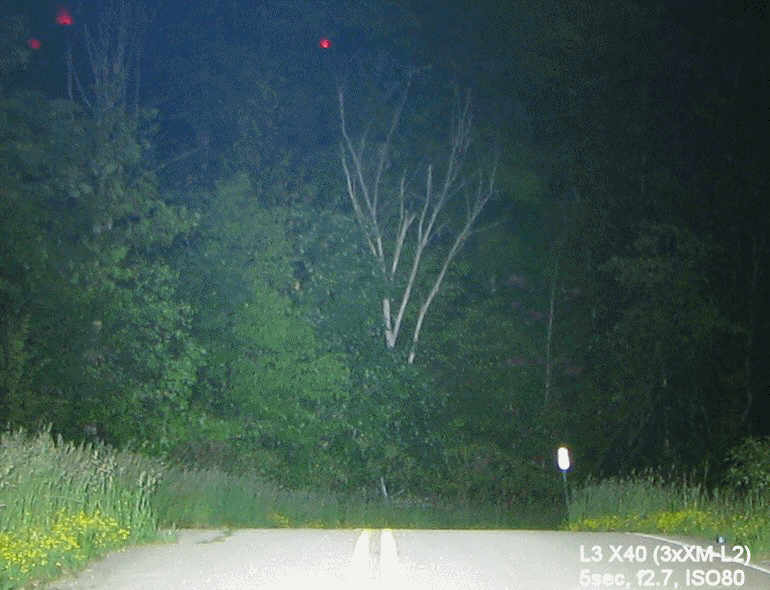
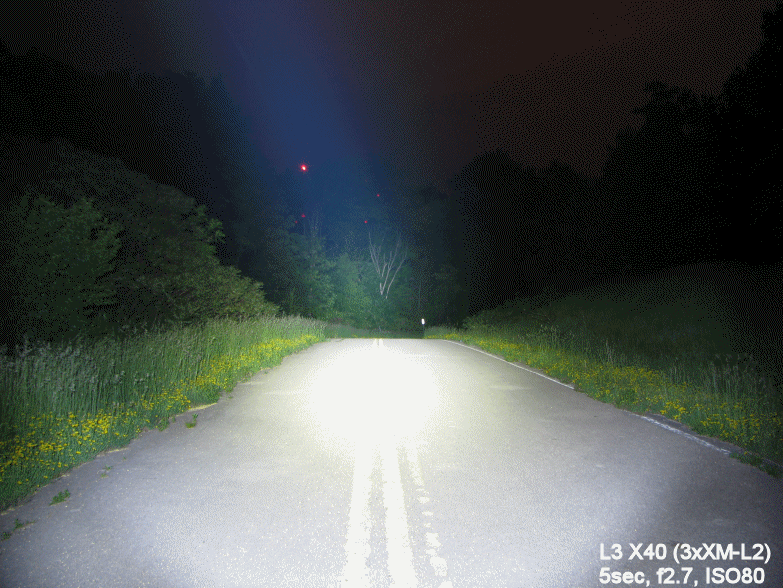
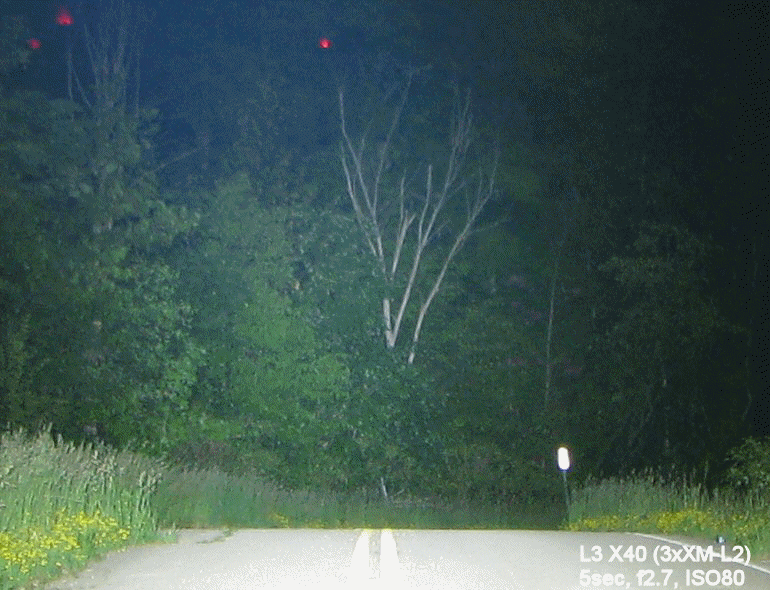
Sorry, the MX25L2 should say "SST-90", not XM-L2 above. :shhh:
Again, despite the slightly variable positioning, you should be able to tell that the X40 has a slightly more focused hotspot over the TN30. Overall output is a touch higher as well, although the difference isn't huge.
Testing Method:
All my output numbers are relative for my home-made light box setup, as described on my flashlightreviews.ca website. You can directly compare all my relative output values from different reviews - i.e. an output value of "10" in one graph is the same as "10" in another. All runtimes are done under a cooling fan, except for any extended run Lo/Min modes (i.e. >12 hours) which are done without cooling.
I have devised a method for converting my lightbox relative output values (ROV) to estimated Lumens. See my How to convert Selfbuilt's Lightbox values to Lumens thread for more info.
Throw/Output Summary Chart:
My summary tables are reported in a manner consistent with the ANSI FL-1 standard for flashlight testing. Please see http://www.flashlightreviews.ca/FL1.htm for a discussion, and a description of all the terms used in these tables. Effective July 2012, I have updated all my Peak Intensity/Beam Distance measures with a NIST-certified Extech EA31 lightmeter (orange highlights).
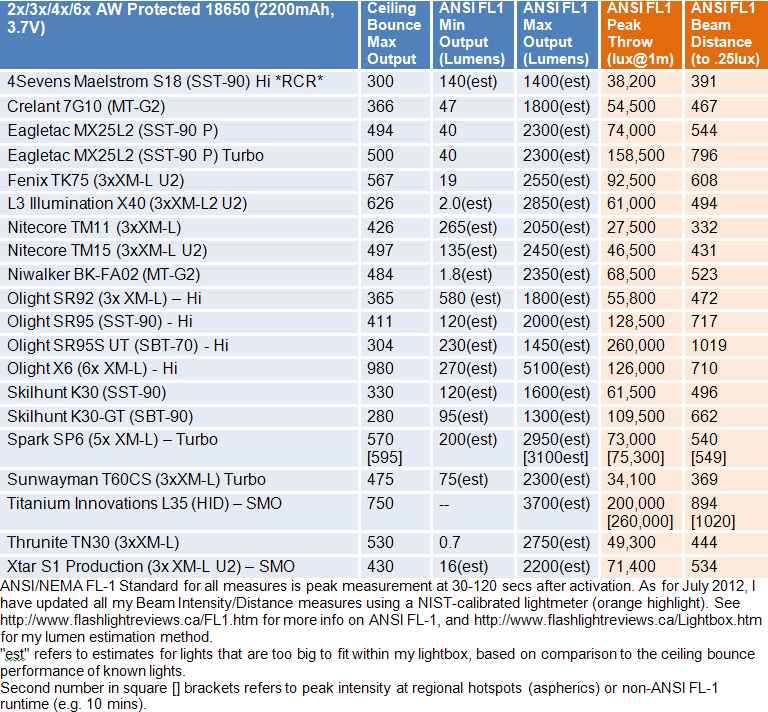
Max output of the X40 is quite high – it is slightly higher than my Thrunite TN30 - which makes the X40 the current output champ among my 3x emitter lights. Throw is also somewhat higher on the X40 compared to the TN30, as you could also tell from the beamshots.
The official specs for the X40 seem a little inflated, for both output and throw. But as always, my output lumen estimates are just that – estimates based on all the lights in my collection. So while I can make no claim to their absolute accuracy, you can trust the relative comparison between lights. Note that my throw measures are direct measures, based on a NIST-certified light meter, and taken under ANSI FL-1 strandard testing conditions (or at least, as close as I can provide).
Output/Runtime Comparison:
Note: All my standard 18650 runtimes are done using AW protected 2200mAh.
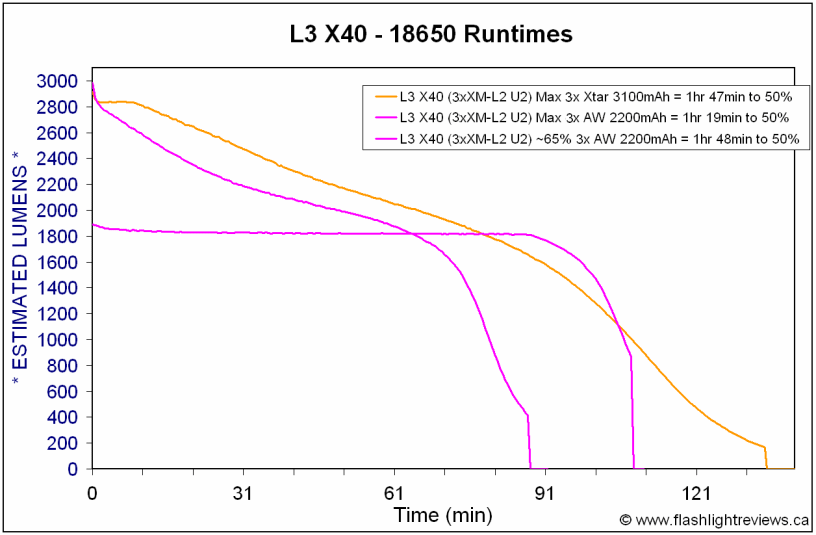
On max, the light appears to be largely direct-drive – but that depends somewhat on the actual 18650 cells used. As you can see above, my 3100mAh cells were able to maintain a relatively stable output for about 10-15mins, before dropping off in a direct-drive-like way. At lower outputs, the light maintains flat regulation for an extended period (on all cells).
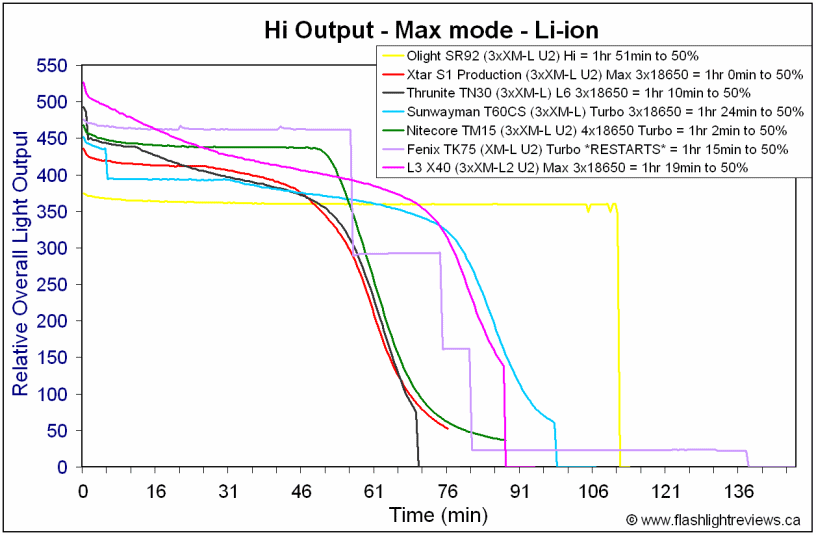
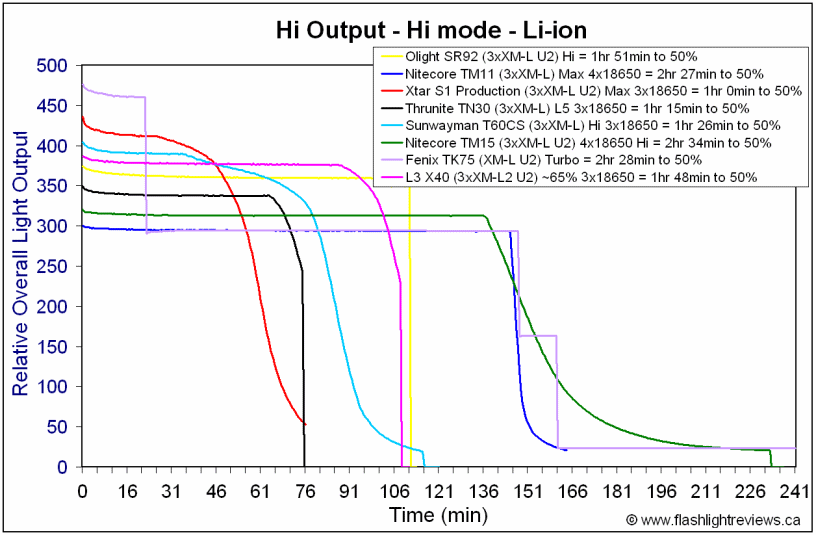
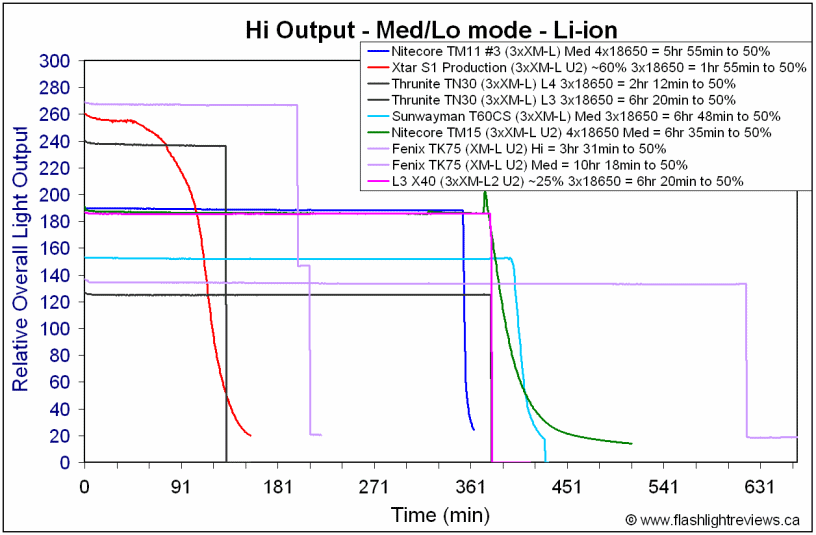
The X40 shows very good overall output/runtime efficiency, at all levels tested. This is again consistent with good current-controlled circuit. But it is all the more impressive when you consider the extended range of outputs available through the ramp. :thumbsup:
Potential Issues
Unlike some of the competition, the X40 doesn't support CR123A or RCR (i.e., 18650 only). But it is not inconsistent to find 18650-only lights in this class.
Due to the overlapping reflector design, there are bound to be some artifacts in the periphery of the spillbeam. The X40 is about "typical" for this class.
The magnetic charging cable worked well in my testing, with no open voltage reading at the tailcap (i.e., no apparent risk of shorting your battery inside the light). However, there is at least a potential risk of shorting your USB port (or worse, an AC outlet if using an adapter) if you don't connect the magnetic end of the cable to the light first (as the magnetic connector of the cable strongly attracts nearby metal). To negate this risk, there is a raised plastic divider on the cable head to seperate the inner and outer ports. You should be fine, but I recommend you keep this point in mind.
Preliminary Observations
The X40 is a top-of-class example of a 3x emitter light. Max output beats all my other 3xXM-L lights (although the TN30 is close), and throw is above average for the class. I note that while my sample came from L3 Illumination, an identical-looking light is also available directly from SupBeam.
Of course, there is more to a light than the mere sum of its max output beam. In terms of build and design, the X40 also has a lot of class-leading features. My favorites incluse the physical clicky off-on switch (i.e., no standby drain) and the visually-linear, continuously-variable ramping control ring. Some other nice touches are the "near-moonlight" mode (i.e., ~2 lumens in my testing), the physical lock out, and an in-light charging solution with no open-voltage at the light. :thumbsup:
To go through that in a little more detail, the continuously-variable ramp actually has a reasonable number of discrete levels - with very good output/runtime efficiency and relatively flat regulation. It is only at the highest outputs where you may see a limited regulation pattern (depending on your cells). But of course, partial direct-drive is a very efficient process, and the drop-off in output is far too gradual for you to notice at these levels. Note as well that the lowest level of the ramp is brighter than the defined "near-moonlight" level. The feel of the control ring is good, with clear detents at major points (and an intuitive orientation).
Build quality is very high overall, and the light has a solid feel. The battery carrier is a particularly solid design, and works well with the in-light charging solution for 18650. The USB-based magnetic charging cable dock is very reminiscent of the Klarus RS11, and worked well in my testing. A nice feature here is that there is no open voltage at the light (and thus no risk of shorting your cells/carrier inside the light).
The beam is about what you would expect for a light this size - good throw, with a certain number of artifacts in the spillbeam. Beam tint bin is described as 1C (i.e., premium cool white), and that seems believable to me.
The X40 is a well-designed, well-built 3xXM-L2 light, with a good number of features. I don't see any significant issues with it - L3/SupBeam definitely seems to have built on the experience of other makers, and assembled a good, comprehensive package. :wave:
----
X40 provided by sbflashlights.com for review.


The X40 is the first light I've reviewed from L3 Illumination – and what a place to start, given the specs (see below). I'll put the light through its paces, and see how it comes out compared to other recent high-output lights. :wave:
Manufacturer's Specifications:
Note: as always, these are only what the manufacturer reports. To see my actual testing results, scroll down the review.
- LED: three Cree XM-L2 U2 LED
- Max 3480 lumens output using 3 * 18650 batteries (not included)
- Infinite brightness magnetic control ring ,minimum brightness : 3 lumen, fully variable from minimum 28 lumen to maximum 3480 lumens; Strobe: 3480 lm. 2.5 102 minutes.
- Working voltage: 4V to 13V.
- Max runtime: 1200 hours.
- Max beam distance: 518 meters.
- Peak beam intensity: 72,000lux (1 meter distance).
- Stainless 304 bezel and antiroll ring
- Direct onboard recharging circuit
- Aircraft grade aluminum body structure.
- Premium type III hard anodized anti-abrasive finish.
- Ultra-clear tempered glass lens with anti-reflective coating.
- Momentary forward click tactical switch.
- Smooth reflector for max light output.
- Mechanical reversed polarity protection design for battery carrier.
- Intelligent highly efficient circuit board design for max performance and long run time.
- Intelligent temperature controlled light output for user safety.
- Impact resistant: 1.2 meters.
- Waterproof to IPX-8 standard, 2M.
- Size: 181mm(L)x 68.00mm(bezel diameter)
- Weight: 520g without battery.
- MSRP: ~$220


My X40 came in a hard cardboard box with cut-out packing foam. Along with the light was a good quality lanyard, belt holster with closing flap, extra o-rings, spare tail switch boot cover, USB charging cable with AC adapter and DC car adapter. The manual wasn't ready when the light was shipped to me, but I was supplied with an electronic copy.



From left to right: AW Protected 18650; Eagletac Protected 3400mAh; L3 X40; Thrunite TN30; Nitecore TM15; Fenix TK75; Niwalker BK-FA02.
All dimensions are directly measured, and given with no batteries installed:
L3 Illumination X40: Weight: 517.2g (~655g with 3x18650), Length: 182mm, Width (bezel): 68.0mm
Fenix TK75: Weight: 516.0g (~700g with 4x18650), Length: 184mm, Width (bezel): 87.5mm
Nitecore TM15: Weight: 450.6g (~634g with 4x18650). Length: 158mm, Width (bezel): 59.5mm
Nitecore TM11: Weight: 342.6g (~526g with 8xCR123A), Length 135.3mm, Width (bezel): 59.5mm
Sunwayman T60CS: Weight: 338.9g (~477g with 3x18650), Length: 145.0mm, Width (bezel): 60.0mm
Thrunite TN30: Weight: 468.2g (~620g with 3x18650), Length: 179mm, Width (bezel): 64.3mm, Width (tailcap): 49.0mm
Xtar S1 Production: Weight: 876.0g (~1028g with 3x18650 protected), Length: 240mm, Width (bezel): 83.4mm
Olight SR92: Weight: 1.15 kg (with battery pack), Length: 271mm, Width (bezel): 98mm
The overall size and weight of the X40 is in keeping with other lights of this class. Note there is a lot of variation in the class, depending on what features you are looking for.




The X40 build is probably most reminiscent of the Thrunite TN30, although with a more distinctive control ring (more on that in a moment). Anodizing is a flat black, and seems to be in very good shape on my sample. Labels are sharp and clear, and include a serial number.
Knurling is present over most of the handle, and is of fairly high aggressiveness. Combined with the control ring flats and heatsink fins in the head, I would say overall grip is pretty good. Light can roll fairly easily, but the indented flats in the head help limit that somewhat.
There are flat indents on the control ring to help with feel. There is a label mark on the control ring that lines up with the labels on the head. Going clockwise, the output modes are min output "3 lms" (first detent), lowest level of the continuously-variable ramp (second detent), output ramp, "max" output (third detent) and "strobe" (fourth detent). The detents are firm at each level, with even resistance across the ramp area.
Screw threads are traditional triangular cut, but seem of good quality.

The light can tailstand stably, and the tailcap cut-outs facilitate access to the switch. Switch is a forward clicky switch (i.e., press for momentary, click for locked-on). Switch feel has a slightly longer traverse than typical, with a definite click. There is a charging dock in the tail that connects to the supplied USB-cable. See below for a discussion.


There is also a small LED indicator. It is green when the light is on and the batteries well charged (or, when charging, if the batteries are fully charged). It is orange when on and the batteries are <50% power. It is red when on and the batteries are <30% (or when batteries are being charged), and flashing red when the on and the batteries are <10%.

There is a triple set of springs in the base, in addition to the spring in the head. The extra set of springs in the tail is obviously required for the charging feature. FYI, I notice the contact board says SupBeam X40 …
Let's take a closer look at the battery carrier:




There is a metal battery carrier that holds 3x 18650 cells. The positive contact points inside the carrier are slightly raised, so all types of 18650 cells should work fine (i.e., true flat-tops, wide and small button-tops). Longer cells may be a bit tight with the base springs, but my protected 3100mAh cells all fit (although some wider cells may make it harder to fit the loaded carrier back into the handle). Unlike other carriers, all the cells point the same way here (i.e., negative terminals at the base, positive terminals toward the head). The carrier is a 3s arrangement (i.e., all cells in series, not parallel).
The carrier only functions one way, with the contact board facing the springs in the tailcap. The inner-most positive contact of the carrier is recessed at both ends, and there is a large metal plate at the carrier end that contacts toward the head. Note that the negative current path is carried by the body of the light. The positive path connects through the spring in the head unit.
Note that CR123A are not supported – the X40 is 3x18650 only.


The charging dock is interesting. Like the Klarus RS11 (which this charging solution resembles), the dock is magnetic and there is no open voltage at the tail (i.e., no risk of shorting when cells are loaded). What you see at the exterior base are two metal circular contacts – these are connected to the terminals of the carrier through the springs. The charging cable directly attaches to the external contacts through a strong magnetic connection, just like the Klarus RS11.


Both AC and 12V DC adapters were provided on my sample.


Because of the strong magnetic pull of the charging cable head (i.e., it will attach itself to anything made of metal), I recommend you connect the head to the flashlight BEFORE you connect the USB end to your computer or an AC power adapter. The reason for this is that when the USB end is plugged in to a power source, I can measure an open voltage at the charger head. Should the magnetic head of the cable then attract a nearby piece of metal, you could potentially short out your USB port (or worse, your AC outlet).

The risk of this is probably fairly low, as there is a raised plastic divider separating the inner and outer contacts on the charging cable to prevent this from happening (i.e., see the pic above with the paperclip). So on a perfectly flat metal surface, you should be fine. But given that the magnet is fairly strong, I wouldn't want to trust that tiny bit of plastic to rule out the potential for even a momentary short. You are better off making sure the magnetic end makes contact before the USB end does.
Using the AC adapter, charging time was a little under 6 hours for fully-drained AW protected 2200mAh cells. The charging rate was longer on just a USB (2.0) port - it took just under 9 hours to full charge my 2200mAh AW cells from the tripped state. This rate seems rather high for me for a standard USB port, so I recommend use of the adapter. I would expect it to take longer for higher capacity cells. Resting voltages for the cells (once the indicator went green) were ~4.15-4.17V, which is quite reasonable.



The X40's reflector has relatively deep emitter wells, overlapping a significant amount in the middle. Although there is no such thing as a "typical" tri-head structure, this seems pretty close to the average of the various heads I've seen. The reflector appears to be in excellent shape on my sample, very smooth, with three reasonably well-centered XM-L2 U2 cool white emitters.
The overall impression of the build is that this is a quality light.
User Interface
Turn the light off/on by the tailcap clicky – press for momentary, press and release (i.e., click) for constant on.
Change output modes by turning the control ring in the head. Arranged from clockwise/left-to-right (looking down at the light, held in traditional flashlight carry), the modes are detent 1 (moonlight) > detent 2 (lowest level of the ramp) > continusouly-variable ramp > detent 3 (max) > detent 4 (strobe).
Note that there is no standby mode – light is always produced when clicked on.
Video:
For more information on the light, including the build and user interface, please see my video overview:
Video was recorded in 720p, but YouTube typically defaults to 360p. Once the video is running, you can click on the configuration settings icon and select the higher 480p to 720p options. You can also run full-screen.
As with all my videos, I recommend you have annotations turned on. I commonly update the commentary with additional information or clarifications before publicly releasing the video.
Ramping Pattern:

The X40's "continuously-variable" ramp is actually composed of a series of discrete steps. Technically, all "continuously-variable" ramps actually have discrete steps – it is just a question of how many there are, and can you notice them. It is hard for me to give a precise number, but I would say there are at least ~25-30 discrete levels in this case.
The raw data coming out my lightbox (above) doesn't actually give you a good feel for how "visually linear" the X40 is. For that, I have plotted the results on a cube root scale, based on modern perceptual research that shows we actually perceive non-point sources of light according to this power relationship:

The X40 ramp looks very linear to my eyes.
Strobe
There is no sign of PWM on any level – I believe the light is current-controlled. Even my moonlight mode was flicker-free. :thumbsup:

The X40 uses a fairly fast "tactical" strobe, of 13.3 Hz. The oscilloscope trace looks a little unusual during the "on" phase, with a quick spike followed by a ramp up and down from max. Not to worry, it is very disorienting.
No Standby Drain
I don't see any evidence of a current drain when the clicky switch is off.
Beamshots:
And now, what you have all been waiting for.
















The X40 definitely has an impressive output level on max. Beam pattern is about "typical" for a tri-head (overlapping well) reflector design – you get reasonable throw, with a lot of artifacts in the spillbeam. It is a bit more focused for throw than the Thrunite TN30.
For outdoor beamshots, these are all done in the style of my earlier 100-yard round-up review. Please see that thread for a discussion of the topography (i.e. the road dips in the distance, to better show you the corona in the mid-ground).
FYI, any "streaks" you see across the images are bug-trails. Flying insects are often attracted to the bright lights, and their flight trails get captured as swirly streaks due to the long exposure time.




Sorry, the MX25L2 should say "SST-90", not XM-L2 above. :shhh:
Again, despite the slightly variable positioning, you should be able to tell that the X40 has a slightly more focused hotspot over the TN30. Overall output is a touch higher as well, although the difference isn't huge.
Testing Method:
All my output numbers are relative for my home-made light box setup, as described on my flashlightreviews.ca website. You can directly compare all my relative output values from different reviews - i.e. an output value of "10" in one graph is the same as "10" in another. All runtimes are done under a cooling fan, except for any extended run Lo/Min modes (i.e. >12 hours) which are done without cooling.
I have devised a method for converting my lightbox relative output values (ROV) to estimated Lumens. See my How to convert Selfbuilt's Lightbox values to Lumens thread for more info.
Throw/Output Summary Chart:
My summary tables are reported in a manner consistent with the ANSI FL-1 standard for flashlight testing. Please see http://www.flashlightreviews.ca/FL1.htm for a discussion, and a description of all the terms used in these tables. Effective July 2012, I have updated all my Peak Intensity/Beam Distance measures with a NIST-certified Extech EA31 lightmeter (orange highlights).

Max output of the X40 is quite high – it is slightly higher than my Thrunite TN30 - which makes the X40 the current output champ among my 3x emitter lights. Throw is also somewhat higher on the X40 compared to the TN30, as you could also tell from the beamshots.
The official specs for the X40 seem a little inflated, for both output and throw. But as always, my output lumen estimates are just that – estimates based on all the lights in my collection. So while I can make no claim to their absolute accuracy, you can trust the relative comparison between lights. Note that my throw measures are direct measures, based on a NIST-certified light meter, and taken under ANSI FL-1 strandard testing conditions (or at least, as close as I can provide).
Output/Runtime Comparison:
Note: All my standard 18650 runtimes are done using AW protected 2200mAh.

On max, the light appears to be largely direct-drive – but that depends somewhat on the actual 18650 cells used. As you can see above, my 3100mAh cells were able to maintain a relatively stable output for about 10-15mins, before dropping off in a direct-drive-like way. At lower outputs, the light maintains flat regulation for an extended period (on all cells).



The X40 shows very good overall output/runtime efficiency, at all levels tested. This is again consistent with good current-controlled circuit. But it is all the more impressive when you consider the extended range of outputs available through the ramp. :thumbsup:
Potential Issues
Unlike some of the competition, the X40 doesn't support CR123A or RCR (i.e., 18650 only). But it is not inconsistent to find 18650-only lights in this class.
Due to the overlapping reflector design, there are bound to be some artifacts in the periphery of the spillbeam. The X40 is about "typical" for this class.
The magnetic charging cable worked well in my testing, with no open voltage reading at the tailcap (i.e., no apparent risk of shorting your battery inside the light). However, there is at least a potential risk of shorting your USB port (or worse, an AC outlet if using an adapter) if you don't connect the magnetic end of the cable to the light first (as the magnetic connector of the cable strongly attracts nearby metal). To negate this risk, there is a raised plastic divider on the cable head to seperate the inner and outer ports. You should be fine, but I recommend you keep this point in mind.
Preliminary Observations
The X40 is a top-of-class example of a 3x emitter light. Max output beats all my other 3xXM-L lights (although the TN30 is close), and throw is above average for the class. I note that while my sample came from L3 Illumination, an identical-looking light is also available directly from SupBeam.
Of course, there is more to a light than the mere sum of its max output beam. In terms of build and design, the X40 also has a lot of class-leading features. My favorites incluse the physical clicky off-on switch (i.e., no standby drain) and the visually-linear, continuously-variable ramping control ring. Some other nice touches are the "near-moonlight" mode (i.e., ~2 lumens in my testing), the physical lock out, and an in-light charging solution with no open-voltage at the light. :thumbsup:
To go through that in a little more detail, the continuously-variable ramp actually has a reasonable number of discrete levels - with very good output/runtime efficiency and relatively flat regulation. It is only at the highest outputs where you may see a limited regulation pattern (depending on your cells). But of course, partial direct-drive is a very efficient process, and the drop-off in output is far too gradual for you to notice at these levels. Note as well that the lowest level of the ramp is brighter than the defined "near-moonlight" level. The feel of the control ring is good, with clear detents at major points (and an intuitive orientation).
Build quality is very high overall, and the light has a solid feel. The battery carrier is a particularly solid design, and works well with the in-light charging solution for 18650. The USB-based magnetic charging cable dock is very reminiscent of the Klarus RS11, and worked well in my testing. A nice feature here is that there is no open voltage at the light (and thus no risk of shorting your cells/carrier inside the light).
The beam is about what you would expect for a light this size - good throw, with a certain number of artifacts in the spillbeam. Beam tint bin is described as 1C (i.e., premium cool white), and that seems believable to me.
The X40 is a well-designed, well-built 3xXM-L2 light, with a good number of features. I don't see any significant issues with it - L3/SupBeam definitely seems to have built on the experience of other makers, and assembled a good, comprehensive package. :wave:
----
X40 provided by sbflashlights.com for review.
Last edited:

